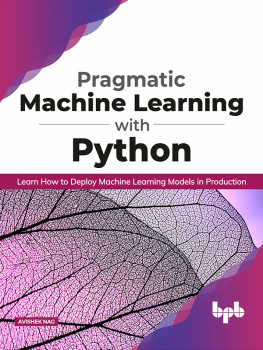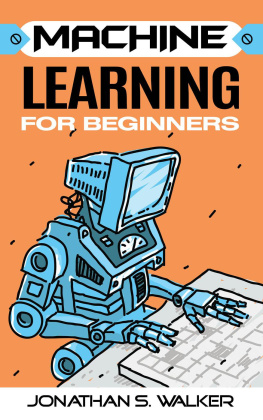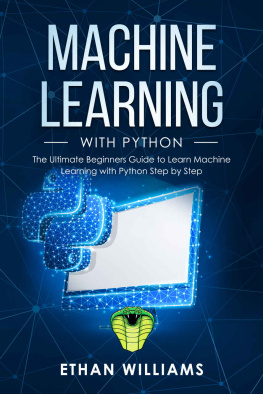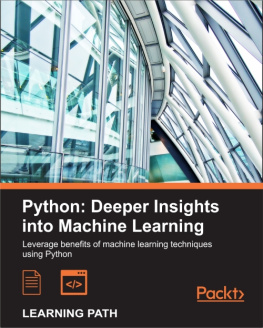Avishek Nag - Pragmatic Machine Learning with Python
Here you can read online Avishek Nag - Pragmatic Machine Learning with Python full text of the book (entire story) in english for free. Download pdf and epub, get meaning, cover and reviews about this ebook. year: 2020, publisher: BPB Publications, genre: Children. Description of the work, (preface) as well as reviews are available. Best literature library LitArk.com created for fans of good reading and offers a wide selection of genres:
Romance novel
Science fiction
Adventure
Detective
Science
History
Home and family
Prose
Art
Politics
Computer
Non-fiction
Religion
Business
Children
Humor
Choose a favorite category and find really read worthwhile books. Enjoy immersion in the world of imagination, feel the emotions of the characters or learn something new for yourself, make an fascinating discovery.
- Book:Pragmatic Machine Learning with Python
- Author:
- Publisher:BPB Publications
- Genre:
- Year:2020
- Rating:3 / 5
- Favourites:Add to favourites
- Your mark:
- 60
- 1
- 2
- 3
- 4
- 5
Pragmatic Machine Learning with Python: summary, description and annotation
We offer to read an annotation, description, summary or preface (depends on what the author of the book "Pragmatic Machine Learning with Python" wrote himself). If you haven't found the necessary information about the book — write in the comments, we will try to find it.
Pragmatic Machine Learning with Python — read online for free the complete book (whole text) full work
Below is the text of the book, divided by pages. System saving the place of the last page read, allows you to conveniently read the book "Pragmatic Machine Learning with Python" online for free, without having to search again every time where you left off. Put a bookmark, and you can go to the page where you finished reading at any time.
Font size:
Interval:
Bookmark:

Learning with
Python

Models in Production


FIRST EDITION 2020
Copyright BPB Publications, India
ISBN: 978-93-89845-365
All Rights Reserved. No part of this publication may be reproduced or distributed in any form or by any means or stored in a database or retrieval system, without the prior written permission of the publisher with the exception to the program listings which may be entered, stored and executed in a computer system, but they can not be reproduced by the means of publication.
LIMITS OF LIABILITY AND DISCLAIMER OF WARRANTY
The information contained in this book is true to correct and the best of authors & publishers knowledge. The author has made every effort to ensure the accuracy of these publications, but cannot be held responsible for any loss or damage arising from any information in this book.
All trademarks referred to in the book are acknowledged as properties of their respective owners.
Distributors:
BPB PUBLICATIONS
20, Ansari Road, Darya Ganj
New Delhi-110002
Ph: 23254990/23254991
MICRO MEDIA
Shop No. 5, Mahendra Chambers,
150 DN Rd. Next to Capital Cinema,
V.T. (C.S.T.) Station, MUMBAI-400 001
Ph: 22078296/22078297
DECCAN AGENCIES
4-3-329, Bank Street,
Hyderabad-500195
Ph: 24756967/24756400
BPB BOOK CENTRE
376 Old Lajpat Rai Market,
Delhi-110006
Ph: 23861747
Published by Manish Jain for BPB Publications, 20 Ansari Road, Darya Ganj, New Delhi-110002 and Printed by him at Repro India Ltd, Mumbai
Late Balaram Nag
My father, who had built the foundations of my life.
Avishek has a Masters degree in Data Analytics & Machine Learning from BITS (Pilani) and a Bachelors degree in Computer Science from West Bengal University of Technology (WBUT). He has more than 14 years of experience in different renowned companies like VMware, Cognizant, Cisco, Mobile Iron, etc. He started his career as a Java developer and later moved to the core area of Machine Learning around five years back. He has practical experience in the design & development of Machine Learning systems, starting from inception to production in multiple organizations. Strong foundations in Mathematics/Statistics and substantial experience in product development had helped him to excel quickly in the world of ML & Data Science. He has shared his knowledge & experience through this book, which will help any Software Engineer to kick start in this area. He also writes blogs, and the same can be found at https://medium.com/@avisheknag17
Outside work, he loves spending time in reading books. He also has a fascination for art & sketch work.
I would like to thank Nrip, Sourabh & team at BPB Publications for giving me this opportunity to write my first book for them.
Being in the industry for around 14 years, I have seen that there is always a massive gap between what we study& what we implement in practical scenarios. Especially for subjects like Machine Learning, which needs a strong theoretical background in Mathematics, this gap will be more. The biggest challenge here is how to take an abstract mathematical theory of a model to the production environment. I have read many Machine Learning books by famous authors and felt that each one is unique in some sense. I thought, if I could contribute from my experience of Industry & Academics here, then I could build a bridge between the theory & practice. This contribution may help a lot of working professionals. Thats the inspiration for writing this book. It is divided into nine chapters. Details of each are given below:
Introduces the concept of Machine Learning (ML) to the reader at a high level. It explains what do we understand by a Model, life cycle of ML projects. It gives a little & high-level understanding of different ML techniques, which are explained in subsequent chapters in detail. This chapter also gives an overview of different mathematical concepts essential to understanding ML models.
discusses the classification techniques. It explains the concept of ML pipeline and gives a short introduction to the scikit-learn library of Python as it would be the default choice of implementation of different ML models. This chapter covers Nave Bayes, Logistic Regression, Decision Tree, and Ensemble model like Random Forest.
is all about regression techniques. It gives a formal algebraic definition of a regression problem and explains two primary methods of solution: OLS & Gradient Descent. It covers topics like feature selection (Forward & Backward), Polynomial form of regression, regularization (Lasso & Ridge), fact explanation from parametric linear model, etc.
covers one unsupervised learning technique: Clustering. It gives formal definition object groups and distances and relates these to clusters. Two main approaches of clustering are discussed here: Centroid-based like KMeans and Density-based like DBSCAN. Apart from usual techniques, Hierarchical clustering like the Agglomerative approach is also discussed. In the end, one unique alternative technique of classification using clustering is covered.
is all about Deep Learning. It starts with the concept of perceptron and defines its components. Then details of Neural networks, its varieties like CNN, Auto encoders are covered. Standard classification & regression using neural network is also discussed.
covers another two unsupervised learning techniques like Dimensionality Reduction with Principal Components and outlier detection techniques. Clustering, Auto-Encoder & an Isolation tree-based approach are discussed under outlier detection.
describes how to process text data and how it is different from other data types. It explains several vector space models like TF-IDF, Doc2Vec, Word2Vec, and how to use these in standard text classification & clustering problems. It also covers text visualization techniques using the standard histogram and Word cloud plot.
describes the techniques of putting ML models into the production environment. It describes probable challenges to do that and possible solutions. Standard specifications like PMML for exporting an ML model in a platform-independent way are described with examples. The architectural technique of scaling up ML models using Big data is also explained.
contains case studies and techniques of writing data science-based stories. Three models with different datasets are prepared & described as stories with the explanation of facts.
Readers are requested to install Python 3 and Jupyter Notebook while reading this book.
bundle and coloured images:
Please follow the link to download the
Font size:
Interval:
Bookmark:
Similar books «Pragmatic Machine Learning with Python»
Look at similar books to Pragmatic Machine Learning with Python. We have selected literature similar in name and meaning in the hope of providing readers with more options to find new, interesting, not yet read works.
Discussion, reviews of the book Pragmatic Machine Learning with Python and just readers' own opinions. Leave your comments, write what you think about the work, its meaning or the main characters. Specify what exactly you liked and what you didn't like, and why you think so.







